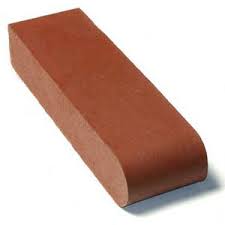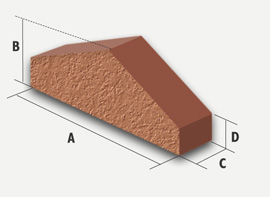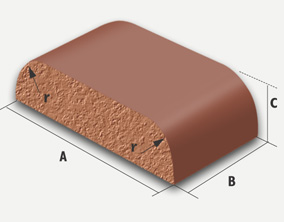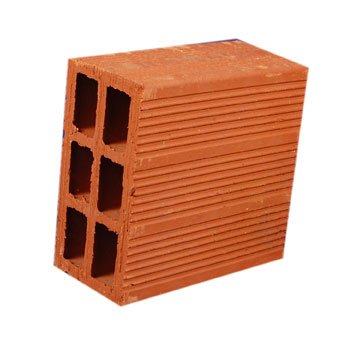Everything About Bricks: Types, Materials, and Construction Methods
Articles > Everything About Bricks: Types, Materials, and Construction Methods
Everything about bricks is described in this article including brick types, materials, and construction methods.
Brick types:
- Bullnose bricks
A brick molded with a rounded angle is termed as a bullnose. It is used for a rounded quoin. A connection which is formed when a wall takes a turn is known as a quoin. The center of the curved portion is situated on the long centre-line of brick.

- Channel bricks
These types of bricks are molded to the shape of a gutter or a channel and they are very often glazed. These bricks are used to function as drains.

- Coping bricks
These types of bricks are made to suit the thickness of walls on which coping is to be provided. Such bricks take various forms such as chamfered, half-round or saddle-back.

- Cownose bricks
A brick molded with a double bullnose on end is known as a cownose.

- Curved sector bricks
These bricks are in the form of curved sector and they are used in the construction of circular brick masonry pillars, brick chimneys, etc.
- Hollow bricks
These are also known as the cellular or cavity bricks. Such bricks have wall thickness of about 20 mm to 25 mm. They are prepared from special homogeneous clay. They are light in weight about one-third the weight of the ordinary brick of the same size. These bricks can be laid almost about four times as fast as the ordinary bricks and thus the use of such bricks leads to speedy construction. They also reduce the transmission of heat, sound and damp. They are used in the construction of brick partitioning.

- Paving bricks
These types of bricks are prepared from clay containing higher percentage of iron. The excess iron vitrifies the bricks at a low temperature. Such bricks resist better the abrasive action of traffic. The paving bricks may be plain or chequered. These bricks are extensively used for garden walks, street pavements, stable floors, etc. These bricks also render the brick floor less slippery.
- Perforated bricks
These types of bricks contain cylindrical holes throughout their thickness. These bricks are light in weight and they require less quantity of clay for their preparation. The drying and burning of these bricks are also easy. If perforated bricks of large size are used, it will result in the increase of output of mason. It has been observed that for tropical countries like India, the bricks with perforations of about 30 to 45 per cent of the total area of the corresponding face of the brick would offer adequate thermal insulation property.The perforated bricks are used in the construction of brick panels for lightweight structures and multi-storeyed framed structures. The perforations may be circular, square, rectangular or any other regular shape in cross-section. The distance between the side of brick and edge of perforation should not be less than 15 mm. The distance between the edges of successive perforations should preferably be not less than 10 mm. The water absorption after immersion for 24 hours in water should not exceed 15 percent by weight. The compressive strength of perforated bricks should not be less than 7 N/mm2 in gross area.
- purpose-made bricks
In order to achieve certain purpose, these types of bricks are made. The splay or cant bricks are made for jambs of doors and windows. The arch bricks are made of wedge shape to keep mortar joint of uniform thickness. Some of the specialized use bricks are:- Fire or refractory – highly heat-resistant bricks.
- Accrington – a type of engineering brick (England).
- Acid brick – acid resistant bricks.
Typical brick dimensions in different countries:
| Standard | Imperial | Metric |
|---|---|---|
 Australia Australia |
9 × 4â…“ × 3 in | 230 × 110 × 76 mm |
 Denmark Denmark |
9 × 4¼ × 2¼ in | 228 × 108 × 54 mm |
 Germany Germany |
9 × 4¼ × 2¾ in | 240 × 115 × 71 mm |
 India India |
9 × 4¼ × 2¾ in | 228 × 107 × 69 mm |
 Romania Romania |
9 × 4¼ × 2½ in | 240 × 115 × 63 mm |
 Russia Russia |
10 × 4¾ × 2½ in | 250 × 120 × 65 mm |
 South Africa South Africa |
8¾ × 4 × 3 in | 222 × 106 × 73 mm |
 Sweden Sweden |
10 × 4¾ × 2½ in | 250 × 120 × 62 mm |
 United Kingdom United Kingdom |
8½ × 4 × 2½ in | 215 × 102.5 × 65 mm |
 United States United States |
7â… × 3â… × 2¼ in | 194 × 92 × 57 mm |
Limitations:
Starting in the 20th century, the use of brickwork declined in some areas due to concerns with earthquakes. Earthquakes such as the San Francisco earthquake of 1906 and the 1933 Long Beach earthquake revealed the weaknesses of unreinforced brick masonry in earthquake-prone areas. During seismic events, the mortar cracks and crumbles, and the bricks are no longer held together. Brick masonry with steel reinforcement, which helps hold the masonry together during earthquakes, was used to replace many of the unreinforced masonry buildings. Retrofitting older unreinforced masonry structures has been mandated in many jurisdictions.
 Read also:
Read also:
- All Types of Foundation Materials
- Types of construction and decorative materials in civil engineering
- Kiln Burnt Bricks; manufacturing procedure
- Different types of masonry
- Calcium Carbonate/Limestone as Civil Engineering Constructions Material
 Share:
Share:
Follow our official Facebook page (@civilengineeringbible) and Twitter page (@CivilEngBible) and do not miss the best civil engineering tools and articles!

